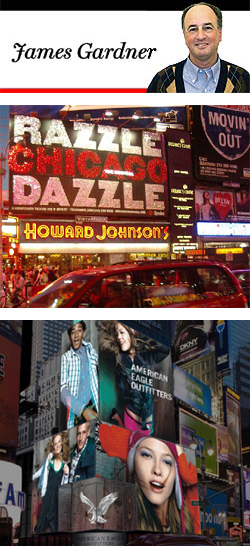Since the day it opened back in 1959, the now vanished Howard Johnson’s in Times Square, at 1551 Broadway at 46th Street, announced a profound change in the once and future crossroads of the world.
Until that time, the intersection had been a fairly elegant and surely vibrant part of the city, where you could take the family. But the arrival of Howard Johnson’s restaurant over 50 years ago confirmed, though it did not cause, the change that would soon lead to the swift and inexorable degeneration of Times Square into a den of prostitution and drug addiction, where respectable people feared to tread. It was fitting then that this Howard Johnson was almost the last vestige of that old Times Square to evaporate, nearly half a century after its opening, thus signaling the definitive victory of resurgent family values.
In place of that now defunct Howard Johnson’s — which closed in 2005 — is the spanking new flagship of American Eagle Outfitters, the designer jeans emporium.
The resulting structure that has arisen over the ghosts of a million middling burgers is striking, especially at night, but in a very real sense, it signals the defeat of architecture. It is a vast wall of LED and LCD tubes created by the Barnycz Group, a Baltimore, Md.-based design firm.
“In Times Square, what we wanted to create for American Eagle Outfitters was a ‘canvas,’” according to Danny Barnycz, the company’s founder and president. This they accomplished by fashioning a multi-tiered interactive high-definition digital 1469 LED panels that covers almost 15,000 square feet and rises up to a 25-story LED tower.
But a canvas is not a building and it would have been nice to see some more substantial structure rise up in this part of Times Square.
In its defense, let it be said that Howard Johnson’s itself was nothing to boast about either. In fact it too was little more than a single-story restaurant whose upper levels were a composite of mismatched billboards.
In the new Times Square, of course, everything is bigger and glitzier, and so the new dispensation creates, through sheer brightness and massiveness, a drama that was lacking before. And it can also be argued that, since the days when this place was still Longacre Square, more than a century ago, its totality was, architecturally speaking, always far more than the sum of its parts.
James Gardner, formerly the architecture critic of the New York Sun, writes on the visual arts for several publications.
